Acoustic Control Cor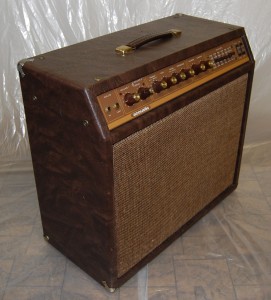 p introduced many innovations into musical instrument amplifiers. They started business during the 1960s. The contributions of Acoustic include front mounting of speakers, removeable grilles, separate preamp and powered speaker enclosures, and the best sounding most dependable equipment ever produced. Acoustic produced very high end musical equipment that featured a lifetime warranty to the original purchaser.
p introduced many innovations into musical instrument amplifiers. They started business during the 1960s. The contributions of Acoustic include front mounting of speakers, removeable grilles, separate preamp and powered speaker enclosures, and the best sounding most dependable equipment ever produced. Acoustic produced very high end musical equipment that featured a lifetime warranty to the original purchaser.
Those amps stacked on the back of the stage with "The Doors" were Acoustics. Acoustic amplifiers were also used by Jaco Pastorius, the Chambers Brothers, Albert King and even Chuck Berry! Acoustic did not have an artist endorsement program - anyone that used Acoustic products had to buy their own!! Even Jimi Hendrix purchased two 260 heads and four 4x12" speaker cabinets - although there is no evidence that he performed or recorded with this equipment.
During the early 1980s, Acoustic deviated from their all solid state amplifier line by introducing three tube amplifier models. This venture was short lived as the design of these amplifiers violated a patent on "mode switching" held by another company and they were pulled from the market within about a year of their introduction.
Acoustic went back to the drawing board, and completely redesigned tube-based amplifiers like the G100T were the result.
Details
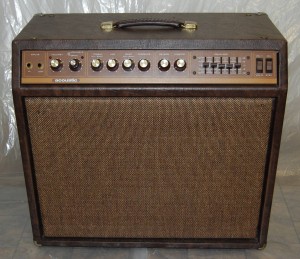 The G100T-112 is a combo style amplifier capable of producing 100 watt RMS through 1-12 inch speaker using 4-6L6GC output tubes (it also uses 3-12AX7 tubes in the preamp and 1-12AT7 as the phase inverter). It is a unique design that provides all of the tone and volume you are looking for, with more than enough flexibility to handle any genre of music you care to play through it. The clean sound is one of the best you will find, and the all tube distortion capability can go from dirty to crunch to a high gain sustain - all of which is very musical with NO solid-state induced clipping.
The G100T-112 is a combo style amplifier capable of producing 100 watt RMS through 1-12 inch speaker using 4-6L6GC output tubes (it also uses 3-12AX7 tubes in the preamp and 1-12AT7 as the phase inverter). It is a unique design that provides all of the tone and volume you are looking for, with more than enough flexibility to handle any genre of music you care to play through it. The clean sound is one of the best you will find, and the all tube distortion capability can go from dirty to crunch to a high gain sustain - all of which is very musical with NO solid-state induced clipping.
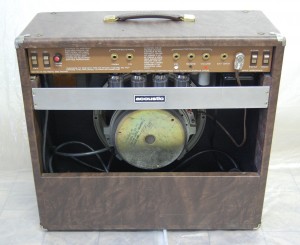 Acoustic didn't skimp on speakers and this amp contains one Electro Voice EVM-12L. The EVM-12L features an 8 spoke cast frame, heavy magnetic structure, 200 watt power rating and high efficiency. The speaker is more than capable of handling the full output of the amplifier and it produces more sound per watt while doing it. The EVM-12L is a very good sounding speaker!
Acoustic didn't skimp on speakers and this amp contains one Electro Voice EVM-12L. The EVM-12L features an 8 spoke cast frame, heavy magnetic structure, 200 watt power rating and high efficiency. The speaker is more than capable of handling the full output of the amplifier and it produces more sound per watt while doing it. The EVM-12L is a very good sounding speaker!
On the front are two inputs, one for low gain and one for high gain. After that are two channels, designated as channel one and channel two. Channel one has a volume control and is meant for clean sounds although very good crunch sounds can be obtained with higher settings of this volume control.
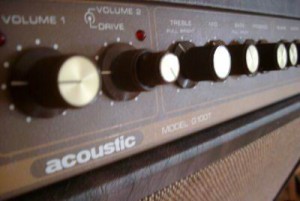 Channel two has a dual stacked control. The inside knob is for gain and the outside knob is for setting the volume level of this channel. Increasing the gain control will increase the amount of distortion and sustain through this channel, and TWO additional tube stages are ready to be be overdriven. The volume portion can balance the level of this channel with the volume of channel one. Two red LEDs above the channel volume controls serve as channel selection indicators as well as "pilot" lights.
Channel two has a dual stacked control. The inside knob is for gain and the outside knob is for setting the volume level of this channel. Increasing the gain control will increase the amount of distortion and sustain through this channel, and TWO additional tube stages are ready to be be overdriven. The volume portion can balance the level of this channel with the volume of channel one. Two red LEDs above the channel volume controls serve as channel selection indicators as well as "pilot" lights.
Channel selection can be performed with a footswitch or by using the front panel channel switch, located next to the standby switch. This amp uses LDR's for switching and there is a slight delay but no clicks or other types of noises when the channels are switched.
Both channels share a common set of four tone controls, Treble, Mid, Bass and Presence. The Treble control has a pull Bright function, and the Bass control has a pull Bass Boost function.
After the tone controls is the effects loop. This is a "serial" effects loop, with send and receive jacks on the back panel, and it is tube buffered for both send and receive functions. There are no send and receive level controls, and there is no separate switching provided for the effects loop.
The signal level through the effects loop is "low level" or -20db... which is appropriate for stomp box effects. Using the effects loop for your stomp boxes instead of using them before the amplifier input will result in a much better signal to noise ratio. Even if you don't use effects, the effects loop would be an ideal location to plug in a volume pedal for overall control with low noise.
After the effects loop is the reverb. A full sized reverb tank, mounted in the bottom of the amp is used. Both the drive and recovery circuits is solid state, and a wide range of reverb can be obtained from a slight expansion effect to all out surf splash. Without a footswitch controlling the reverb, the reverb is normally on. It's depth is controlled by the front panel reverb control.
The Master Volume control is next, and it's setting determines the overall volume of the amp, regardless of which input channel is being used or how its volume control is set.
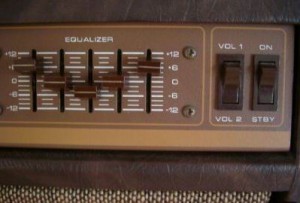 After the Master Volume is the graphic equalizer. The graphic equalizer is "normalized" to be in the circuit when there is not a footswitch plugged in, and to switch it out requires a footswitch. The equalizer has five bands centered around the frequencies of 100, 220, 800, 2.5k and 5K hz. These frequencies are not indicated on the front panel, and all five sliders provide up to 12db of boost or cut.
After the Master Volume is the graphic equalizer. The graphic equalizer is "normalized" to be in the circuit when there is not a footswitch plugged in, and to switch it out requires a footswitch. The equalizer has five bands centered around the frequencies of 100, 220, 800, 2.5k and 5K hz. These frequencies are not indicated on the front panel, and all five sliders provide up to 12db of boost or cut.
The graphic equalizer is tube based and that means it is high impedance. The slider's location is directly in front of the power transformer, so when the equalizer is on the hum level increases. It is not a significant increase and it does not vary with the volume of the amp. So for most normal playing situations at higher volume levels you won't notice it. But if you are trying to do some quiet bedroom practice, you will. The solution is to not use the graphic equalizer, and without a footswitch all you have to do is insert an open phone plug into the footswitch jack to disable it. With the graphic equalizer off, the amplifier is very quiet.
The power switch, ground switch and fuse are located together on the left of the back panel. The amp is set up for 120 volt operation, but on the underside of the chassis there is a switch (under a screwed on "no-tamper" plate) to change the power supply voltage to 240 volts. You can see the edge of the plate in the picture.
The footswitch jacks, all three of them, are clustered together on the back panel. Each one will accept a standard 1/4" mono phone plug, and any footswitch that opens or completes a ground connection can be used. The "Volume" jack is for the channel switching. To set up the amp for channel switching, the front panel channel switch should be in the Channel One position.
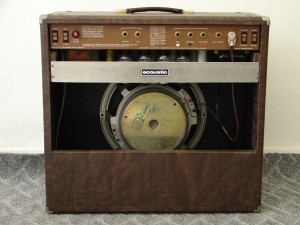 The far right of the back panel has the speaker jacks, the impedance selector (4 or 8 ohms) and the "50W/100W" switch. The 50W position removes two of the output tubes from the circuit resulting in only 50 watts RMS of power output.
The far right of the back panel has the speaker jacks, the impedance selector (4 or 8 ohms) and the "50W/100W" switch. The 50W position removes two of the output tubes from the circuit resulting in only 50 watts RMS of power output.
This amplifier is built like a tank and weighs like one - approximately 70 pounds according to the bathroom scales - and that doesn't include packing. The amp's enclosure measures 22" wide by 20" tall by 10 1/2" deep. The wood of the enclosure measures approximately 5/8" thick, and it is very sturdy.
There are eight bolts/screws, four on top and two on each side that fasten the amplifier chassis to the case. The chassis itself is very clean and the transformers are not rusted.
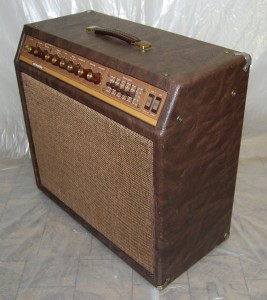 The grille cloth is in good shape. The electronics are in complete working order - no scratchy controls and every function of this amplifier works as it should. And as you can tell by the up close pictures, both front and back panels are in great shape. It has all of its original control knobs.
The grille cloth is in good shape. The electronics are in complete working order - no scratchy controls and every function of this amplifier works as it should. And as you can tell by the up close pictures, both front and back panels are in great shape. It has all of its original control knobs.
This amplifier has not been modified in any way, and there have been no electronic repairs - as none have ever been necessary.
Acoustic Control Corporation has been out of business for some time. So of course these amps are no longer being made - and very few modern amps are manufactured with the high quality of parts that Acoustic required.
p introduced many innovations into musical instrument amplifiers. They started business during the 1960s. The contributions of Acoustic include front mounting of speakers, removeable grilles, separate preamp and powered speaker enclosures, and the best sounding most dependable equipment ever produced. Acoustic produced very high end musical equipment that featured a lifetime warranty to the original purchaser.
